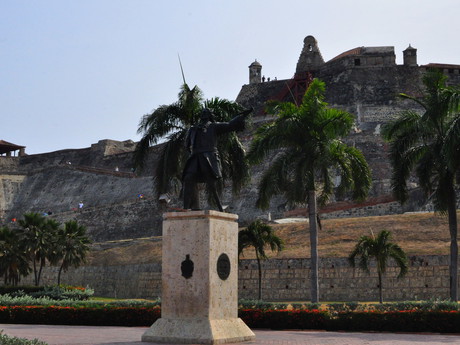Colombia: Cartagena - a city by the Caribbean Sea

Spring Reading Is Brought to You By:

Cartagena is the largest port and the most important industrial hub in Colombia. It is a large city with vast suburbs and home to over million people. This is a large city founded by Pedro de Heredia in 1533. After that, it became the main Spanish port in the Caribbean Sea. Treasures taken from the natives were stored there so it became a place sought after by pirates. And it was even under siege for five times in the 16th century. Therefore, the Spaniards created an unconquerable port of Cartagena and built thick ramparts. No wonder than that the largest fortress the Spaniards had ever built in their colonies is right here, in Cartagena.
Its name is Castillo de San Felipe de Barajas. It is a complex system of communications and escape routes. The fortress was built in 1536 and expanded as needed until 1657. After about two hours, we leave it and go for a walk through the historic center. There is always something to photograph while walking the cobbled streets. The main gate to the inner city used to stand at the site of today's Puerta del Reloj. The clock on it comes from Switzerland.
Behind the gate is the Plaza de los Coches square with a statue of the city's founder - Pedro de Heredia. This square used to serve as a marketplace for the slave trade. The largest square in Cartagena is called Plaza de la Aduana and was used for parades, in honor of which there is a statue of Christopher Columbus. Administrative buildings were built around the square during the Spanish rule. There is also a building where the founder of the city lived.
The church and the cloister of San Pedro Claver were both built in the early-17th century by the Jsuits. Its name honors missionary San Pedro Clavero who fought against slavery. His bodily remains rest in an urn inside the main altar. Catedral de Santa Catalina de Alejandría is the residence of the archbishop of Cartagena.
Its construction began in 1575. However, the tower was partly damaged by the pirate Francis Drake in 1586. The renovation works took place between the years 1598 and 1612. A dome and marble facade were added. The entire old town is surrounded by thick ramparts - Las Murallas - to protect this part of the city. Their construction began in the late-16th. century and ended two centuries later.
To fully enjoy atmosphere of this colonial city, we don't need to visit museums. It is enough to simply walk in historic center and enjoy all the colorful streets, historical buildings and their balcons decorated with flower beds. On Plaza de Bolivar there are dance groups which entertain passers-by. Everything comes alive at night here. As there are so many tourists, stores, and restaurants, worry not about taking a walk in dark. Some buildings are lit with amazing illumination. Also, we think we should try some street food so we buy an arepa. It is a round type of meal fried or baked. It can also be sweetened. Aperas are prepared differently in different regions. Our first one we ever tasted was in Cartagena and it was cheesy. Well, we were not impressed.
Cartagena at night is very noisy. Horse-drawn carriages ride in the city centre all night and operate as taxi for tourists. And everyone seems to be shouting. Well, the center of Cartagena is not a place to have a good-night sleep. Add mosquitos biting you all night long and you get idea of how nights look like there. At five in the morning we are having high hopes of noise getting calmer. But local vendors start to opening their sstands and they shout at each other across the street.
Cartagena is a beautiful city but it is quite noisy for our taste. Two days and two nights are just enough to move on again. Now we travel north to the resort of Santa Marta.
GPS: 10°25'32.2"N 75°32'51.6"W
Text and photos: Tomáš Novák
| Discussion at the article (0) |
Related Articles

Colombia, Medellin - the city of spring and Escobar

Colombia: Cali - city of salsa

Colombia: ancient Santa Marta

Colombia: Salento - between the mountains

Colombia: Bogota - the capital of the country

Colombia: Tunja, and Villa de Leyva

Colombia: San Gil and Barichara

Colombia: San Juan de Girón

Colombia: from Medellin to Cartagena across Santa Fe

Panama, Ciudad de Panamá – The City and the Panama Canal
Related Photogallery

Colombia: A Drug Land Turned Tourist Paradise
Guide:
Important Information:
![]() Information and warnings on travelling abroad is to be found HERE.
Information and warnings on travelling abroad is to be found HERE.

































